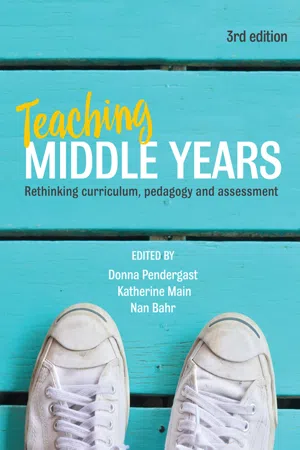
Teaching Middle Years
Rethinking curriculum, pedagogy and assessment
- 432 pages
- English
- ePUB (mobile friendly)
- Available on iOS & Android
Teaching Middle Years
Rethinking curriculum, pedagogy and assessment
About this book
Teaching Middle Years has established itself as the most respected Australian text to focus on the adolescent years of schooling. Recognition of the educational importance of this age group continues to grow as research reveals the benefits of programs designed especially for young people's needs.
This third edition provides a systematic overview of the philosophy, principles and key issues in middle schooling, together with a new depth of focus on the emotional problems and behavioural challenges in working with students. The editors explore in detail two key areas in middle years pedagogy - differentiation and engagement - and there are new chapters on achieving effective transition, the importance of physical activity in adolescence, and how to develop cooperative and collaborative learning.
Featuring contributions from leading experts in the field, and fully revised and updated to reflect the latest research, Teaching Middle Years will assist both pre-service and in-service teachers to bring out the very best in their students.
Praise for the first edition:
'Teaching Middle Years gives the reader many ideas and examples based on sound research. It's an excellent coverage of the current thinking in this critical area of education.'- from Teacher: The National Education Magazine
'Offers educators a combination of theoretical constructions based on Australian and international research and practical suggestions for teaching middle years students based on the proven good practices of many effective middle years teachers.' - from the Australian Journal of Middle Schooling
'This book should be required reading for every middle school leader who strives to better understand and facilitate middle level learning and achievement.' - from Choice: Current Reviews for Academic Libraries
Frequently asked questions
- Essential is ideal for learners and professionals who enjoy exploring a wide range of subjects. Access the Essential Library with 800,000+ trusted titles and best-sellers across business, personal growth, and the humanities. Includes unlimited reading time and Standard Read Aloud voice.
- Complete: Perfect for advanced learners and researchers needing full, unrestricted access. Unlock 1.4M+ books across hundreds of subjects, including academic and specialized titles. The Complete Plan also includes advanced features like Premium Read Aloud and Research Assistant.
Please note we cannot support devices running on iOS 13 and Android 7 or earlier. Learn more about using the app.
Information
Part One
The middle years
Chapter One
Middle years education
- introduce the field of middle years education
- consider factors that shape middle years education
- engage in a three-step strategy to develop a school-based philosophy for middle years education.
Introducing middle years education
Why focus on middle years education?
- the need to manage a heterogeneous student population without sacrificing inclusiveness
- a decline in student academic performance
- a high incidence of disengagement, disruptive behaviour, boredom and disconnection from schooling
- a knowledge gap between what is taught and the kind of content that would engage early adolescents and match their cognitive skills
- transition, which often entails major change.
Middle years education in Australia
- Clear philosophy relevant to the context.
- …
- higher order thinking strategies
- integrated and disciplinary curricula that are negotiated, relevant and challenging Provocation 1.1 Understanding middle years studentsYou are a new middle years teacher. The sketch in Figure 1.1 shows a group of four friends who are studying Year 8 together and are within six months of age. As their new classroom teacher you have made a few assumptions about the students based on their appearance. The image is a simple depiction of the variation of physical development that exists even in a group as small as this. As you get to know the students you realise that appearance is no indicator for cognitive maturation or for other readiness aspects of learning. You also realise that these four are at very different points of psychosocial maturity.
 Figure 1.1 Four friendsAs a middle years educator, what are your first steps to understanding the students in your class—and not just these four, but the entire 30?
Figure 1.1 Four friendsAs a middle years educator, what are your first steps to understanding the students in your class—and not just these four, but the entire 30?
- heterogeneous and flexible student groupings
- cooperative learning and collaborative teaching
- authentic and reflective assessment with high expectations
- democratic governance and shared leadership
- parental and community involvement in student learning.
Factors that shape middle years education
Middle years curriculum, pedagogy and assessment
Table of contents
- Cover
- Half Title
- Title Page
- Copyright Page
- Dedication Page
- Contents
- Tables, figures and provocations
- Abbreviations
- Contributors
- Preface
- PART 1 The middle years
- PART 2 Curriculum practices in the middle years
- PART 3 Pedagogical practices in the middle years
- PART 4 Assessment practices in the middle years
- PART 5 Middle years education in action
- Acknowledgements
- References
- Index